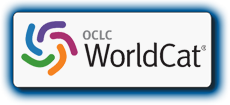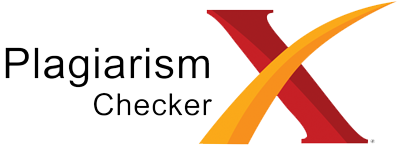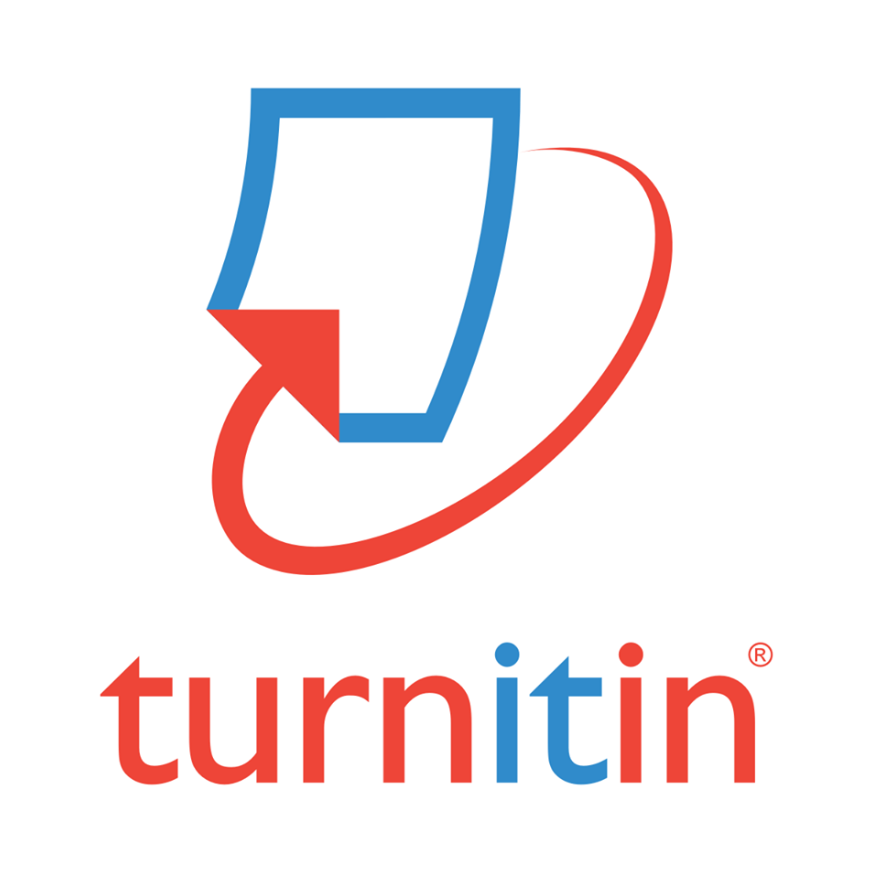Pengaruh Strategi Pembelajaran Fisika Berbasis Website Terhadap Hasil Belajar Pada Siswa yang Memiliki Selfregulated Learning (SRL) yang Berbeda
Abstract
Abstrak: Penelitian ini bertujuan untuk menguji perbedaan hasil belajar antara kelompok siswa yang diajar dengan pembelajaran fisika berbasis website dengan kelompok siswa yang diajar pembelajaran berbasis video. Selanjutnya untuk mengetahui perbedaan hasil belajar antara kelompok siswa yang memiliki self-regulated learning yang berbeda dan untuk menjelaskan interaksi antara pembelajaran fisika berbasis website dan self-regulated learning terhadap hasil belajar. Rancangan penelitian adalah kuasi eksperimen dengan desain faktorial 2X2. Subjek penelitian terdiri atas dua kelompok yang diajar dengan pembelajaran fisika berbasis website dengan pembelajaran fisika berbasis video. Instrumen yang digunakan untuk mengukur hasil belajar siswa adalah tes hasil belajar, sedangkan untuk menentukan self regulated learning (SRL) menggunakan angket self regulated learning (SRL). Hasil analisis menunjukkan ada perbedaan hasil belajar antara kelompok siswa yang diajar dengan pembelajaran fisika berbasis website dengan kelompok siswa yang diajar Pembelajaran Berbasis Video. Hasil uji menunjukkan bahwa hasil belajar antara kelompok siswa yang belajar fisika berbasis website memiliki nilai lebih tinggi 7,82 % dibandingkan dengan kelompok belajar fisika yang berbasis video. Ada perbedaan hasil belajar antara kelompok siswa yang memiliki self-regulated learning yang berbeda. Hasil uji menunjukkan bahwa hasil belajar antara kelompok siswa yang self regulated learning tinggi memiliki nilai sebesar 19,53% lebih tinggi dibandingkan self regulated learning rendah. Ada interaksi antara pembelajaran fisika berbasis website dan self-regulated learning terhadap hasil belajar.
Abstract: This study aims to examine differences in learning outcomes between groups of students taught by website-based physics learning and groups of students taught video-based learning. Furthermore, to determine the differences in learning outcomes between groups of students who have different self-regulated learning and to explain the interaction between website-based physics learning and self-regulated learning on learning outcomes. The research design was a quasi-experimental study with a 2X2 factorial design. The research subjects consisted of two groups taught by website-based physics learning with video-based physics learning. The instrument used to measure student learning outcomes is a test of learning outcomes, while to determine self-regulated learning (SRL) uses a self-regulated learning (SRL) questionnaire. The results of the analysis show that there are differences in learning outcomes between groups of students taught by website-based physics learning and groups of students taught by Video-Based Learning. The test results showed that the learning outcomes among the group of students who studied physics based on the website had a higher score of 7.82% compared to the physics learning group based on the video. There are differences in learning outcomes between groups of students who have different self-regulated learning. The test results showed that the learning outcomes between groups of students with high self-regulated learning had a value of 19.53% higher than those with low self-regulated learning. There is an interaction between web-based physics learning and self-regulated learning on learning outcomes.
Keywords
Full Text:
PDFReferences
Angkowo, R. dan Kosasi, A. 2007. Optimalisasi Media Pembelajaran. Jakarta: Penerbit PT Grasindo.
Arsyad. 2004. Media Pembelajaran. Grafindo Persada. Jakarta. Chen, S.C. 2002. Self-Regulated Learning strategies and Achievement in an introduction to Information Systems Course. Information Technology, Learning, and Performance Journal, (1), (online), (http://www.osra.org/itlpj/chenspiring2002.pdf), diakses tanggal 2 September 2012.
Cheryl, L. M. 2003. Supporting and Fasilitating Self Directed Learning. Published by James Rhem and Associaties, LLC (ISSN 1057-2880)
Chularut, P. & DeBecker, T. K. 2004. The Influence of Concept Mapping on Achivement, Self-regulation, and Self Efficacy in Studies of English as a Second Language. Contemporary
Educational Psycology, (Online), 29:248-263, (http://www.sciencedirect.com/), diakses tanggal 28 Desember 2012
Cohen, L., Manion, L. and Morrison, K. 2011. Research Methods in Education (7thed.). London: Routledge
Corno, L. 2012. Volitional aspects of self-regulated learning. In B.J. Zimmerman and DH. (http://www.clomedia.com /content /templates.asp?articleid= 24&zoneid= 30%20/clofeature diakses 18 September 2012)
Cramer, K.M. 2006. Virtual Lecture Hall For In-Class and Online Sections: A Comparison of Utilization, Perceptions, And Benefits. Journal of Research on Technology in Education, Vol. 38, 102-134.
Finger, G., McGlasson, M., & Finger, P. 2007. Information adn Communication Technologies: Towards a Mediated Learning
Context. In Y. Inoue (Ed.), Technology and Diversity in Higher Education (pp. 81-102). Hershey, PA: information Science Publishing
Gainau, M. B. 2011. Hubungan Antara Pola Asuh Orang Tua, Motivasi Belajar, Self-Regulated Learning Dengan Hasil Belajar Siswa Smp Negeri Di Kota Malang. Disertasi tidak diterbitkan: PPS Universitas Negeri Malang
Ghozali, I., 2009. Aplikasi Analisis Multivariate dengan program SPSS. Semarang: Badan Penerbit Universitas Diponegoro.
Hughes, M. & Hagie C. 2005. The Positive and Challenging Aspects of Learning Online and in Traditional Face-to-Face Classrooms: A Student Perspective. Journal of Special Education Technology, Vol. 20, (8-52).
Jacobsen, Eggen, dan Kauchak. 2009. Methods for Teaching: Promoting Student Learning in K-12 Classrooms. Upper Saddle River,NJ: Allyn & Bacon
Kerlinger, F. N., 2000. Asas-asas penelitian behavioral. Terjemahan oleh Landung R. Simatupang, 1990. Yogyakarta: Gajah Mada University Press.
Kozma, R.B. 2003. ICT and Educational Change: A Global Phenomenon. In R. B. Kozma (Ed.), Technology, Innovation, and Educational Change: A global perspective (pp. 1 – 18). Eugene, OR: International Society for Technology in Education (ISTE)
Latham, A. 1999. Research Link. Educational Leadership. November, Vol 56, No.14. 88-89
Lynch, R. & Dembo, M. 2004. The Relationship between SelfRegulation and Online Learning in a Blended Learning Context. International Review of Reseach in Open and Distance Learning, (Online), 5 (2): 1-16, (http//www.Irrodl.org/index.php/irrodl/article/view/189/799), diakses tanggal 6 September 2012.
Min, C. 2008. Online discussion and critical thinking skills: A case study in a Singapore secondary school. Australasian Journal of Educational Technology: 556-573.
Palacios, A. Gascon, G. 2010. SelfRegulated Learning Environments. Attitude As Antecedent variable, ICERI2010 Proceedings,.
Pavlik, J.V. 1996. New Media Technology. Culture and Commercial Perspectives. Singapore: Allyn and Bacon.
Prabu, A. dan Markus, I.M. 2006. Efektifitas Penggunaan Software Pesona Fisika dalam Pembelajaran Fisika di SMA Santa Ursula BSD Setyosari, Punaji. 2010. Metode Penelitian
Pendidikan Dan Pengembangan. Kencana
Sugiharti, P. 2005. “Penerapan Teori Multiple Intelligence dalam Pembelajaran Fisika,” [Versi elektronik] Jurnal Pendidikan Penabur 5, 29-42.
Tsai, C. Shen, P. & Tsai, M. 2011. Developing An Appropriate Design of Blended Learning with WebEnabled Self-Regulated Learning to Enhance Students’ Learning and Thoughts Regarding Online Learning. Behaviour & Information Technology, (online), 30 (2): 261-271, (http://web.ebscohost.com),diakses 8 Agustus 2012.
Tucker, S. 2001. Distance Education: Better, Worse, or as Good as Tradisional Education? Online Learning of Distance Learning administration, 4(4).
Uno H. B., 2008, Model Pembelajaran Menciptakan Proses Belajar Mengajar yang Kreatif dan Efektif, Jakarta: Bumi Aksara
Usman, B. & Asnawir. 2002. Media Pembelajaran. Jakarta: Delia Citra Utama.
Varaki, B. S. 2006. A Reflection on Three Web-Based Teaching Critical Thinking: Toward A Compromise Approach. Ankara University, Journal of Faculty of Educational Sciences, year: 2006, vol: 39, no: 2.
Wolters, C.A. Pintrich, P.R., Karabenick, S.A. 2003. Assesing Academic self regulated learning. Conference on indicator of positive Development: Child Trends
Zerr, R. 2007. A Quantitative and Qualitative Analysis of the Effectiveness of Online Homework in First-Semester Calculus. The Journal of Computers in Mathematics and Science Teaching. Austin. Vol. 26 (112-136
Zimmerman, B.J. 2002. Becoming a self-regulated leaner: An overview. Theory into Practice. Vol 41. Number 2, Spring Autumn, 64-70. (online), (http:// commonsenseatheism.com/ wp-content/ uploads/ 2012/02 /Zimmerman-Becoming-aself-regulated-leaner.pdf),diakses tanggal 14 desember 2112.
Refbacks
- There are currently no refbacks.
Copyright (c) 2017 Mohammad Djamil M. Nur

This work is licensed under a Creative Commons Attribution-ShareAlike 4.0 International License.
Edcomtech: Jurnal Kajian Teknologi Pendidikan published by Department of Educational Technology, Faculty of Education, State University of Malang in Collaboration with Asosiasi Program Studi Teknologi Pendidikan Indonesia (APS TPI) and Ikatan Profesi Teknologi Pendidikan Indonesia (IPTPI) with MoU.
Publisher Address:
Lab. Teknologi Pendidikan, Gd.E2, Lt.1
Fakultas Ilmu Pendidikan Universitas Negeri Malang
Jalan Semarang No 5, Kota Malang Kode Pos 65145
Email: edcomtech.fip@um.ac.id
========================================================================================================
| INDEXED BY | TOOLS | PLAGIARISM CHECK | ARTICLE TEMPLATE |
|

Edcomtech is licensed under a Creative Commons Attribution-ShareAlike 4.0 International License.
Edcomtech Statistics (Since July 13th, 2020)

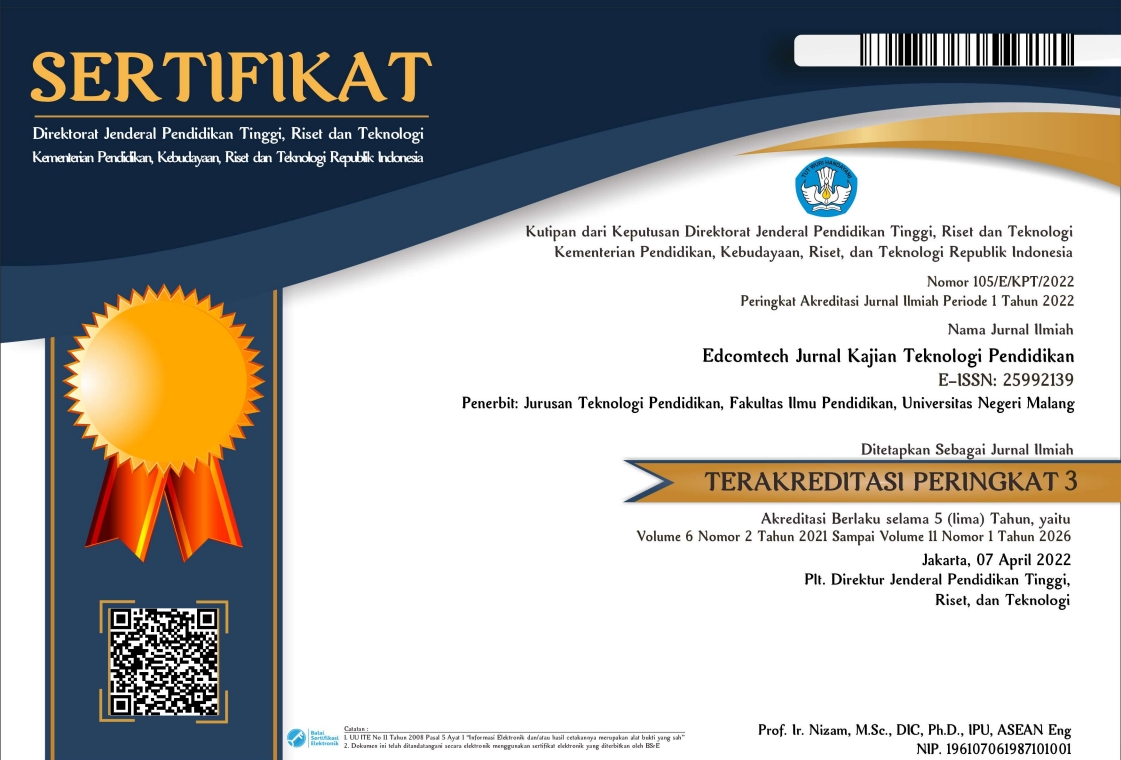
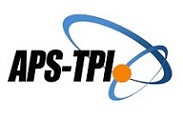


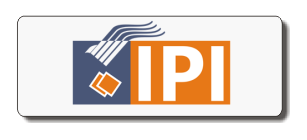





1.png)
